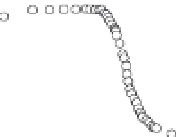Geology Reference
In-Depth Information
upper
terrace surface
hinge graben
P
1
P
2
x
x
x
x
x
x
x
x
x
x
x
x
x
x
x
x
x
x
T
1
x
x
amount
of offset
20
18
16
14
12
10
8
6
4
2
0
x
8.4m
x
x
P
3
x
x
x
x
T
1
x
x
x
x
x
x
x
x
x
7.7m
x
x
offset terrace
surface
P
4
x
x
x
T
1
x
x
x
x
x
x
x
x
x
x
x
x
x
8.7m
x
x
x
x
x
T'0
x
x
x
x
x
A
x
x
9.0m
x
x
x
x
x
T'0
x
x
x
x
x
x
x
x
T'0
x
x
x
x
x
?
hinge
graben
B
Deformed
Terraces
20
15
survey points
10
9.7-m offset
of terrace surface
5
C
0
0
100
200
300
Horizontal distance (meters)
Fig. 2.15
Faulted fan surfaces of the Tien Shan.
A. Surveyed offsets of the surface of alluvial fans where displaced by a thrust fault. Fresh faults scarps have been
degraded. B. Interpretation of the schematic structure beneath the faulted terraces. Note that even small irregularities
in the surface, such as the “hinge graben,” can sometimes be interpreted in terms of the underlying structure. C. On
surfaces displaying several meters of local relief, displacements of the “average” down-fan gradient can be derived
from surveyed profiles. Modified after Avouac
et al.
(1993).
erosional surfaces are identified by the low
relief of the uplifted surface, deep weathering
of an undulating regional surface, an
accordance among summit heights, and/or the
smoothly varying topography of broadly folded
or faulted terrains. Most commonly, the actual
erosion surface is no longer preserved because
slow bedrock weathering has exhumed through









































































































































































